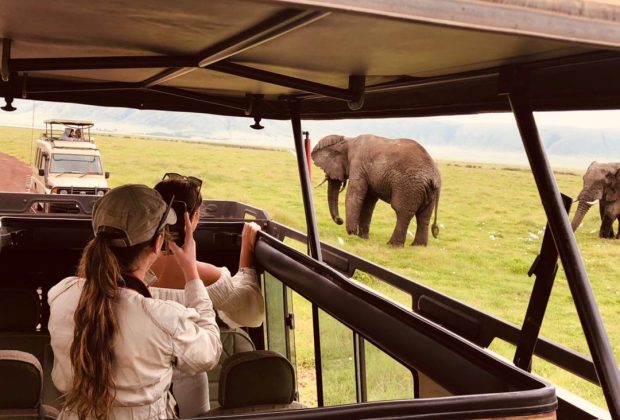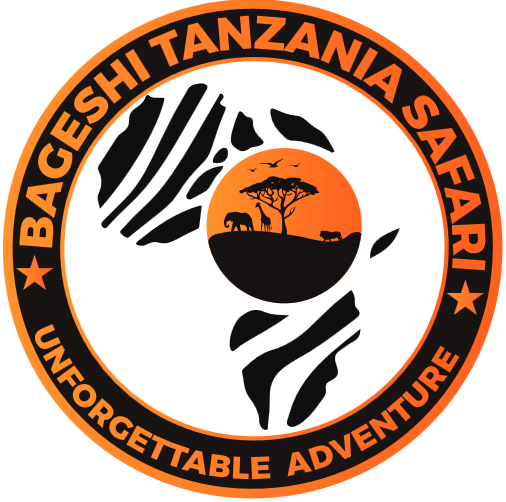Tanzania has a varied geography, including deep and large freshwater and salt lakes, many national parks, and Africa’s highest point, Mount Kilimanjaro (5,895 m or 19,341 ft)
Northeast Tanzania is mountainous and includes Mount Meru, an active volcano, Mount Kilimanjaro, a dormant volcano, and the Usambara and Pare mountain ranges. Kilimanjaro attracts thousands of tourists each year.
West of those mountains is the Gregory Rift, which is the eastern arm of the Great Rift Valley

On the floor of the rift are a number of large salt lakes, including Natron in the north, Manyara in the south, and Eyasi in the southwest. The rift also encompasses the Crater Highlands, which includes the Ngorongoro Conservation Area and the Ngorongoro Crater. Just to the south of Lake Natron is Ol Doinyo Lengai (3,188 m or 10,459 ft), the world’s only active volcano to produce natrocarbonatite lava. To the west of the Crater Highlands lies Serengeti National Park, which is famous for its lions, leopards, elephants, rhinoceroses, and buffalo plus the annual migration of millions of white bearded wildebeest. Just to the southeast of the park is Olduvai Gorge, where many of the oldest hominid fossils and artifacts have been found.
Further northwest is Lake Victoria on the Kenya–Uganda–Tanzania border. This is the largest lake in Africa by surface area and is traditionally named as the source of the Nile River. Lake Victoria covers 69,490 sq km (26,832 sq miles), which is Africa’s largest lake and 49% of it lies in Tanzania. Southwest of this, separating Tanzania from the Democratic Republic of the Congo, is Lake Tanganyika . This lake is estimated to be the deepest lake in Africa and second deepest lake in the world after Lake Baikal in Siberia, with maximum depths of 1,470m (4,821ft), and is 673km (420 miles) long and averages 50km (31 miles) across; 41% of its area lies in Tanzania. The western portion of the country between Lakes Victoria, Tanganyika, and Malawi consists of flat land that has been categorised by the World Wildlife Fund as part of the Central Zambezian Miombo woodlands ecoregion. Just upstream from the Kalambo Falls, there is one of the most important archaeological sites in Africa.
Posted onVerified Unique trip with Bageshi to four national parks in Tanzania We spent a week traveling with Bageshi from Arusha via Tarangiere, Ngorongoro to Serengeti. It was a wonderful time, with unique animal experiences but also overall exciting impressions and encounters with the country and people in Tanzania. The hotels and lodges we booked were great! Great location in the national parks and always friendly and committed staff everywhere. We felt comfortable and safe everywhere. Our guide looked after us optimally, led us to unique animal encounters with his knowledge, his instinct and his connections and always got us quickly but safely from A to B (including changing tires in over 30 degrees and sun); really a full commitment on all levels. The communication in German worked great and we laughed a lot together :) We can highly recommend the Northern Circuit in Tanzania!Posted onVerified I was sceptical but had the time of my life My friends dad convinced me to do this and I wasnt sure if it s really my thing. Im glad I did it. We had the time of our lives there. Didnt expect to see all the animals and especially all big 5 but we did :D it was stunning. In on of tje lodged we had elefants in front of our breakfast table. Amaaaaazing! We were kind of lucky to have a guide like Mashaka because he was always full of energy, up for exploring and showing us the most amazing and secret places. I felt like that many other the other company's guides seemed a bit low in energy or unmotivated but not sure. Anyways, he knew all the 4 parks we visited like the back of his hand and we had a lot to talk about???? I can recommend this company and Mashaka without hesitation.Posted onVerified Best Safari ever It was a wonderful safari in a very private setting. The lodges that were chosen were top notch... Marshaka Bay he is the bestPosted onVerified The best of the best !! The company offers best quality services I have ever seen. We were traveling with kids 3 and 9 years old. We were afraid before trip that it would be too hard for little girls but is was amazingly easy!! The driver - owner of the company is real family man with very good mood everyday no matters the situation. Amazing stories -10!! Tanzania country history - 10!! Funny jokes -10!! Helping check in check out in hotels - 10!! Planning the route every day with snacks stops -10 !! Sincerity and help- 20!! We where together for 4 days and became very good friends. Visited 3 parks with lots of wild animals . I highly recommend this company for your vacation in Tanzania because it is unforgettable!! Hope to come back soon and to see more parks together !!Posted onVerified Absolut zu empfehlen ! Wir waren nun bereits 2x mit Bageshi tanzania Safari unterwegs und können dieses Safari Unternehmen absolut empfehlen ! Vertrauenswürdig , zuverlässig und gut organisiert! Wir hatten unglaublich schöne Unterkünfte , die liebevoll von Bageshi ausgesucht wurden . Unser Guide sprach perfekt deutsch und hat uns viel über Land , Kultur und Tiere erzählt . Wir hatten wirklich eine tolle Zeit zusammen und werden sicherlich nochmal bei Bageshi buchen !Posted onVerified Traum Reise Wir haben mit Mashaka eine Ware Traum Reise gehabt , er hat einfach so eine herzliche Art an sich das wir immer gute Laune hatten . Auch seine Erfahrung wie er fährt und die ganzen Informationen über die Tiere und Landschaft sind ein ganz besonderer Vorteil. Wir haben uns auf der ganzen Reise sehr wohl gefühlt. Wir würden ihn immer wieder buchen. ????????????????????????Posted onVerified Unbeschreiblich! :) Hallo zusammen, Ich kann euch wirklich empfehlen hier zu buchen! Wir waren anfang April auf Safari und fanden es einfach großartig! Die Tiere, das Land, die Menschen... ! Unser Guide war sehr höflich und ging auf all unsere wünsche ein. Er sprach sehr gut deutsch & englisch und konnte uns alle ihm gestellten Fragen kompetent beantworten und hatte auch interessante Geschichten über Land und Leute zu erzählen. Wir hatten viel zu staunen, lernen, genießen und lachen! Die Big 5 zu sehen war einer unser größter wünsche und dank unserem Guides ging dieser auch in erfüllung! Unsere nächste Reise nach Tansania wird sicher hier gebucht werden!! Es war einfach Toll! :)Posted onVerified Afrika Trip We were in Africa for the first time and our trip could not have been better, we saw all the Big 5, the landscape was impressive and our private guide Mashaka spoke great German and English. He taught us a lot and was able to answer all of our questions about the animal world and vicinity . it was a great experience!Thanks for that !Posted onVerified Traumsafari mit Bageshi Tanzania Waren letzten Sommer auf Safari mit Bageshi Tanzania als Familie zu viert. War einfach nur ein einzigartiges Erlebnis!!! Komfortables Fahrzeug und der beste Fahrer, den man sich vorstellen kann! M sprach perfekt deutsch und hatte enorme Fachkenntnisse bzgl Tiere etc. Wir hatten einfach nur einen riesen Spaß zusammen....zudem beeindruckende Landschaften, wunderschöne Lodges mit super Essen und Service out of Africa! Unbedingt empfehlenswert!
